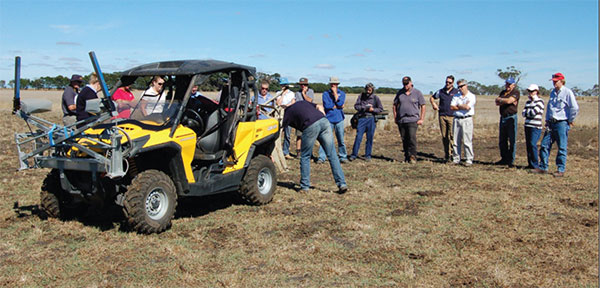VLPA Update
PETER MCCLUSKEY provides an update on the Victorian Limestone Producers Association.
REDUCING SOIL ACIDIFICATION THROUGH NUTRIENT MANAGEMENT
WestVic Dairy, with input from VLPA, held two field days at Macarthur and Grassmere in March to advise farmers how they can make soil testing more representative of the whole of their pasture needs. This in turn can lead to making best use of lime application.
The field days were funded through Glenelg Hopkins Catchment Management Authority’s Caring for Country grants. Wortleys’ farm at Macarthur and Roches’ farm at Grassmere have both been involved in the Reducing Soil Acidification through Nutrient Management which WestVic
Dairy’s Jeff Lawes spoke about at the VLPA conference in 2012
The following report of the events appeared in the Warrnambool Standard on 4/4/13.
Andrew Speirs from Mike Stephens and Associates in Casterton told the field days “there could be huge variations in nutrient levels from the front to the back paddocks on dairy farms. … On one test, the soil pH varied from 4.9 to 5.6 depending on the location of the gate and trough…. Regularly monitoring appropriate paddocks on transects allows the correct fertilizer to be made on an area basis, not on a blanket basis.”
He also urged farmers to take preventative action if aluminium cation levels started to rise and to apply lime as soon as aluminium was noticed in the system. He said liming was essential if pH levels were less than 4.4 in CaAl2 as it was starting to do damage to the clay lattice in the soil. “The more active root system you have the better off you will be.”

VLPA Chairman Kevin Matthews in blue cap to right of picture.
At the field days, Brendan Torpy of Precision Agriculture from Ballarat demonstrated the Veris soil pH mapping unit which is mounted to a CanAm quad bike and equipped with a highly GPS (as pictured in the above photo).
The soil pH probe inserts into the soil generating pH results within 5 seconds. While not quite as accurate as lab tests for pH, the pH change trends across the paddock are easily mapped by this equipment and do correlate well with laboratory pH tests.
BLUE GUM GRINDER ALSO RIPS THROUGH LIMESTONE DEPOSIT
Readers will recall our last article in Sand & Stone on R&H Stonecrushing’s Blue Gum grinder. Well the company’s Brad Herbertson tells your correspondent he has been using the equipment to rapidly remove overburden at sites in SA and then grind through limestone deposits at 200 tonnes in 4 hours as good as screened and ready for road base application.
More on this in following editions!
Further information is available from Peter McCluskey on 0408 496 588.









You must be logged in to post a comment Login